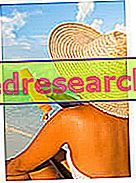A simple and effective food strategy based on very complex physiological mechanisms
Chronobiology, or the science that studies biological rhythms, has led to the formulation of chronodiet, a food strategy based on the time of food intake.
This food strategy is based on circadian variations of different biological functions, which in turn are based on hormonal changes during the day.
In short it is not only important to ask how and how much to eat but also when to eat .
Chronodieta and Hormonal Control
Hormonal control is the basis on which it is based, not only the chronodieta, but also most of the latest scientific research on nutrition and weight loss. The much loved and discussed zone diet is an example. Based on these theories the assimilation of nutrients and the consequent metabolic variations depend on a complex network of hormonal adjustments.
There are hormones that promote the accumulation of body fat and the loss of muscle mass and others that favor the disposal of body fat and the purchase of muscle mass. Stimulating with the diet the secretion of one or the other hormone means reaching or not your goals; Not only that, it is important to assess individual hormone levels since some individuals may experience a natural hyper or hypoproduction of certain hormones.
Time Bands for the Assumption of Various Foods
In the chronodiet, conceived in 1992 by two Italian doctors, it is advised to take the carbohydrates at the beginning of the day.
It is therefore not a question of limiting only their intake but also of distributing their intake during the 24 hours, concentrating it in the morning and early afternoon.
The bread and all other foods with a high carbohydrate content should therefore be taken in the morning as at this stage of the day the liposynthetic and anabolic action of insulin is counteracted by corticosteroid hormones (cortisol). Not only that, the activities carried out during the day allow to metabolize most of the energy introduced with food in the first part of the day.
Lunch Carbohydrates, Evening Protein
If on the one hand it is important for supporters of chronodiet to reduce the intake of carbohydrates in the evening hours, on the other the protein consumption will have to be increased precisely during this time of the day.
The hormonal profile that is established in the evening hours favors the use of fats for energy purposes and the building of muscle mass during the night.
The following table shows the main hormones on which chronodiet is based, for each is indicated the circadian function and rhythm
| HORMONE | FUNCTION | CIRCADIANO RHYTHM | PRINCIPLES OF THE CRONODIETA |
| GH | Promotes protein synthesis (increases muscle mass) and stimulates lipolysis (use of fats for energy purposes) | He reaches his acrophase around 24 and records his minimum values from 8 to 20 | Protein consumption should be increased in the evening hours to encourage the building of muscle mass |
| Cortisol | Promotes the loss of muscle mass (especially in the lower limbs) and at the same time promotes the accumulation of fat in the abdominal region | Peak (acrophase) recorded around the earliest hours of the morning (3-4) and minimum peak which coincides with the first hours of night rest (22-24) | Carbohydrates should be taken in the morning as at this stage of the day the liposynthetic and anabolic action of insulin is counteracted by high cortisol levels |
| INSULIN | It is the anabolic hormone par excellence, it favors the synthesis of glycogen, proteins but also fats; it is a hypoglycemic hormone, meaning it lowers blood sugar | Virtually absent, with a marginal role, its main regulator is glycaemia, or the quantity of sugars present in the blood | Promotes fat accumulation; is activated by a meal rich in carbohydrates that should be taken in the morning to counteract its actions thanks to the high levels of cortisol |
| glucagon | It is a hyperglycemic hormone, an insulin antagonist that promotes the rise in blood sugar | Virtually absent, with a marginal role, its main regulator is glycaemia, or the quantity of sugars present in the blood |
THE EVOLUTION OF THE CHRONODIET
At its origins the chronodiet was in effect a dissociated diet, a diet that imposed not only the consumption of certain nutrients at particular times of the day, but also the prohibition of taking at the same meal foods of different origins (for example it was necessary separating the consumption of carbohydrates from that of proteins).
Obviously such a drastic method cannot but have some negative implications. The following table shows the pros and cons of the chronodiet.
Positive, Negative and Discussable Aspects
| POSITIVES | DOWNSIDES | DEBUT ASPECTS |
| Consume foods by distributing them in 4-5 daily meals. Importance of breakfast The evening meal must be sufficiently detached from the moment of sleep. Avoid taking food at night. | It is not necessary to weigh the various foods and there is a certain freedom in the quantities of food to be consumed as long as they are taken at set times. It is proposed as the ideal diet for many categories of people in reality, there are many cases in which such a dietary approach is not recommended. Little room for the culinary tastes of the subject who is obliged to eat not according to his wishes but based on his watch | Prefer whole foods to refined foods. Eat fruit, cereals and all foods rich in simple carbohydrates by early afternoon. Choose carbohydrates instead of rice and corn. Eat whole foods rather than refined. To digest carbohydrates better, thus obtaining less fat accumulation, do not associate them with protein foods such as fish, eggs and meat (especially pork). At dinner, favor proteins, avoiding carbohydrate intake. Do not drink wine, beer and coffee in combination with carbohydrates Remember that lunch should be the meal most plenty of it Consume seasonal fruits and vegetables |
In the following table we see how it is possible to make positive some criticizable principles of the chronodiet
| FROM CRITICABLE | A POSITIVE |
| Eat whole foods rather than refined. | In the absence of contraindications, prefer whole foods instead of refined ones, making sure that they come from controlled biological sources |
| Eat fruits, cereals and all foods rich in simple carbohydrates by early afternoon | In the absence of contraindications, it is recommended to limit the ingestion of simple carbohydrates to dinner, preferring complex ones (whole grains, vegetables and non-sugary fruit). |
| Among the carbohydrates, prefer rice and corn | In the absence of contraindications, consume mainly complex carbohydrates such as bread, pasta, rice and corn, reduce the consumption of simple sugars |
| To digest carbohydrates better, therefore obtaining a lower accumulation of fat, do not associate them with protein foods such as fish, eggs and meat (especially pork). | The association of carbohydrates and proteins leads to an increase in digestion times which favors the fermentation of sugars and the onset of gastrointestinal problems in some individuals |
| For dinner, focus on protein, avoiding carbohydrate intake. | At dinner, especially if consumed at a short distance from the night rest, favor proteins limiting carbohydrate intake. |
| Don't drink wine, beer and coffee in combination with carbohydrates. | Limit the consumption of alcoholic substances; coffee does not facilitate digestion, but rather increases gastric acidity. |
| Remember that lunch should be the most abundant meal | Consume foods by distributing them in 4-5 daily meals, two main ones (lunch and dinner), an intermediate one (breakfast) and one or two minor meals (snacks) |
| Consume seasonal fruits and vegetables | Preferably consume seasonal fruits and vegetables; make sure of their origin by carefully reading the labels; avoid foods from non-EU countries where controls on pesticide use are reduced |
Another important aspect to consider is the individual variability, for example some people usually eat dinner when they come back from work and then go to the gym a few hours later, a similar speech for shift workers, or for those who continue until late at night; in all these cases the principles contained in the chronodiet are not applicable and also the evening meal must contain, for obvious reasons, carbohydrates in good quantities.
Also be careful not to demonize corticotropic hormones at all costs, as the main lipogenetic hormone (which favors the accumulation of fat) is not cortisol but insulin. Taking too many simple sugars (or with a high glycemic index) causes at any time of the day an over-production of insulin necessary to counteract the glycemic increase. It is questionable to say that during morning hypercotisolism it is useful to take many simple carbohydrates as hypercortisolism promotes hyperglycemia which will be further increased by a meal rich in carbohydrates; increasing blood sugar means increasing the secretion of insulin with all the negative consequences we have previously listed.
In addition to an easier accumulation of fat, hyperinsulinemia contributes to the premature appearance of the sense of hunger; on the contrary, the consumption of a balanced meal, in addition to keeping blood sugar and insulin levels relatively constant, slows digestion and helps to give a general sense of satiety.
Last point to consider is that in the late afternoon there are the highest peaks of body temperature and consequently the energy metabolism is very high. So it would not be so wrong to continue taking carbohydrates even in the early and late afternoon, limiting them only in the evening meal.
Extrapolate the Positive Elements
There is no perfect diet, correct eating habits exist, information exists and there are contraindications, for these reasons the main rule is, and remains the same, to contact a specialized doctor before embarking on any diet program.
The chronodiet, as we have seen, contains several positive points that need to be extrapolated and included in one's technical and cultural background. On the other hand, however, it is not without its incorrect aspects and its extreme concepts that must therefore be abandoned.
See also: The chronodiet of Dr. Todisco
The chrono-feeding


